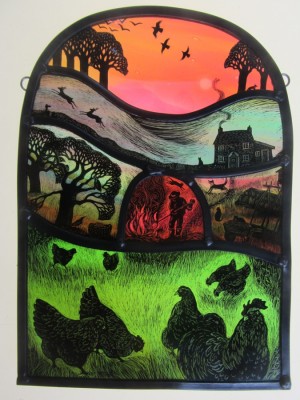I'm sorry not to have written a post for a while, but now that the holiday season has come to an end I'm back up to my elbows in slurried clay and new ideas! Like this.....
Take a look at this wonderful piece of art from American potter, Michael Kline.
This is a stoneware clay plate inlayed with porcelain. A fantastic piece of work. Michael puts videos up on his Facebook as well as Periscope and I've watched him doing this technique several times in order to give it a go myself. However, my attempt is in the kiln at this moment which is why I've chosen Michael's perfect plate as the finished example.
So this is how he does it....
First, stamp a pattern on your leather-hard work making sure you have reasonably deep impressions.
I have very few purpose-made stamps, in fact only one actually, so I used bits of lava from Lanzarote, shells from the Kent coast and even an old cheap ring that was meant to resemble something that Princess Diana got engaged with. This gave me perfect flower shapes. (Must hunt the toy shop for more little girls' trinkets.)
Now we're ready for the porcelain.
I added water to some soft porcelain and mixed it until I had quite a smooth, watery consistency. This is important as the first coat needs to soak into all the nooks and crannies.
After this you can use a slightly thicker porcelain and keep brushing it on until the pattern almost disappears and the surface looks smoothish.
Now, let it dry before tackling the exciting bit.
With a sharp tool carefully scrape away at the surface and soon you will see the white pattern emerging. My clay isn't very dark so when this little beauty comes out of the kiln I suspect that the contrast between the two clays will be a tad disappointing, but this is my first attempt, from which I'll learn. Hopefully. Then fire as usual and dip in a transparent glaze. I'll show you this fired cup next time.
So, what else is new in the workshop? Before the summer I was glazing everything blue. (see the previous post) But since the hot, hot days we enjoyed in August I've found myself mixing up the brightest of yellows.
And as you can see, I still love working with my wax resist technique.
Bright colours, and especially yellow, seem to be loved by everyone this year. Lots of sales.
Here's a photo of the bottom of our garden from last autumn. It backs onto a huge field, and beyond that, a water-meadow that slopes down to our River Leam.
A little bit colourless you may think, but no... from this open space our daughter Rosie has collected blackberries, walnut leaves, wild marjoram, nettles, grasses and sedge. And this is what she has been working at.
'Meadowsweet Yarns' by Rosie Bill
All natural dyes picked from our water-meadow. Stunning colours Rosie, I like the yellows best — but then I would! Her Etsy shop should be up and running this winter.
Sometimes we like to give ourselves a treat and Alan has just bought himself a wonderful 'F' Irish Whistle. It's red, an unusual colour for an instrument, but he only has 8 or 9 silver ones in the box labeled 'Alan's whistles'. And, as he said, it's really a birthday present to himself. What will I buy him when he celebrates... next March??
But I can't talk because I have just bought a little expensive something this morning.
Hows about that eh??
It's still in the box but when I get it out tomorrow it is going to transform my working life! You can perhaps see what it is but it's a bit special.
It'll take me out of the darkness and into daylight. Next post will have an in-depth review of this cheeky little piece of equipment.
HAPPY POTTING FOLKS























